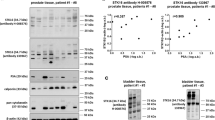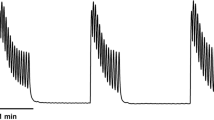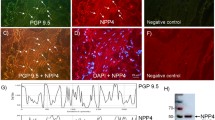Abstract
The aim of this study is to evaluate the potency of piboserod (SB 207266), a selective 5-HT4 receptor antagonist, at inhibiting the 5-HT4-mediated potentiating effect of serotonin (5-HT) on the neurally-mediated contractile responses of human detrusor strips to electrical field stimulations (EFS). Strips of human detrusor muscle were mounted in Krebs-HEPES buffer under a resting tension of 500 mg and EFS (20 Hz, 1 ms duration at 300 mA for 5 s) was applied continuously at 1 min intervals. After stabilization of the EFS-induced contractions, concentration-response curves to 5-HT (0.1 nM–100 μM) were constructed in the absence or presence of 1 or 100 nM of piboserod. The experiments were performed in the presence of methysergide (1 μM) and ondansetron (3 μM) to block 5HT1/5HT2 and 5-HT3 receptors, respectively. 5-HT potentiated the contractile responses to EFS of human bladder strips in a concentration-dependent manner, with a maximum mean of 60.0±19.9% of the basal EFS-evoked contractions. Piboserod did not modify the basal contractions but concentration-dependently antagonized the ability of 5-HT to enhance bladder strip contractions to EFS. In presence of 1 and 100 nM of piboserod, the maximal 5-HT-induced potentiations were reduced to 45.0±7.9 and 38.7±8.7%, respectively. A mean apparent antagonist dissociation constant value (KB) of 0.56±0.09 nM was determined. These data show the ability of piboserod to antagonize with high potency the enhancing properties of 5-HT on neurally-mediated contractions of isolated human bladder strips. Therefore, the 5-HT4 receptor might represent an attractive pharmacological target for the treatment of overactive bladder.



Similar content being viewed by others
References
Andersson KE (2004) Antimuscarinics for treatment of overactive bladder. Lancet Neurol 3:46–53
Arunlakshana O, Schild HO (1997) Some quantitative uses of drug antagonists. Br J Pharmacol 120:151–161 (originally published 1958)
Bayliss M, Wu C, Newgreen D, Mundy AR, Fry CH (1999) A quantitative study of atropine-resistant contractile responses in human detrusor smooth muscle, from stable, unstable and obstructed bladders. J Urol 162:1833–1839
Boyd IW, Rohan AP (1994) Urinary disorders associated with cisapride. Adverse Drug Reactions Advisory Committee. Med J Aust 160:579–580
Candura SM, Messori E, Franceschetti GP, D’Agostino G, Vicini D, Tagliani M, Tonini M (1996) Neural 5-HT4 receptors in the human isolated detrusor muscle: effects of indole, benzimidazolone and substituted benzamide agonists and antagonists. Br J Pharmacol 118:1965–1970
Chapple CR, Radley SC, Martin SW, Sellers DJ, Chess-Williams R (2004) Serotonin-induced potentiation of cholinergic responses to electrical field stimulation in normal and neurogenic overactive human detrusor muscle. BJU Int 93:599–604
Corsi M, Pietra C, Toson G, Trist D, Tuccitto G, Artibani W (1991) Pharmacological analysis of 5-hydroxytryptamine effects on electrically stimulated human isolated urinary bladder. Br J Pharmacol 104:719–725
Etienne M, Verlinden M, Brassinne A (1988) Treatment with cisapride of the gastrointestinal and urological sequelae of spinal cord transection: case report. Paraplegia 26:162–164
Gaster LM, Joiner GF, King FD, Wyman PA, Sutton JM, Bingham S, Ellis ES, Sanger GJ, Wardle KA (1995) N-[(1-butyl-4-piperidinyl)methyl]-3,4dihydro-2H-[1,3]oxazino[3,2- a]indole10-carboxamide hydrochloride: the first potent and selective 5-HT4 receptor antagonist amide with oral activity. J Med Chem 38:4760–4763
Hanson P,.Soler JM (1989) The effect of cisapride on the neurogenic bladder. Acta Belg Med Phys 12:81–88
Hindmarsh JR, Idowu OA, Yeates WK, Zar MA (1977) Pharmacology of electrically evoked contractions of human bladder. Br J Pharmacol 61:115P
Pillans PI,.Wood SM (1994) Cisapride increases micturition frequency. J Clin Gastroenterol 19:336–338
Sanger GJ, Banner SE, Smith MI, Wardle KA (1998) SB-207266:5-HT4 receptor antagonism in human isolated gut and prevention of 5-HT-evoked sensitization of peristalsis and increased defaecation in animal models. Neurogastroenterol Motil 10:271–279
Tonini M,.Candura SM (1996) 5-HT4 receptor agonists and bladder disorders. Trends Pharmacol Sci 17:314–316
Tonini M, Messori E, Franceschetti GP, Rizzi CA, Castoldi AF, Coccini T, Candura SM (1994) Characterization of the 5-HT receptor potentiating neuromuscular cholinergic transmission in strips of human isolated detrusor muscle. Br J Pharmacol 113:1–2
Wardle KA, Bingham S, Ellis ES, Gaster LM, Rushant B, Smith MI, Sanger GJ (1996) Selective and functional 5-hydroxytryptamine4 receptor antagonism by SB 207266. Br J Pharmacol 118:665–670
Acknowledgement
This study has been sponsored by GlaxoSmithKline.
Author information
Authors and Affiliations
Corresponding author
Rights and permissions
About this article
Cite this article
Darblade, B., Behr-Roussel, D., Gorny, D. et al. Piboserod (SB 207266), a selective 5-HT4 receptor antagonist, reduces serotonin potentiation of neurally-mediated contractile responses of human detrusor muscle. World J Urol 23, 147–151 (2005). https://doi.org/10.1007/s00345-005-0499-z
Received:
Accepted:
Published:
Issue Date:
DOI: https://doi.org/10.1007/s00345-005-0499-z




